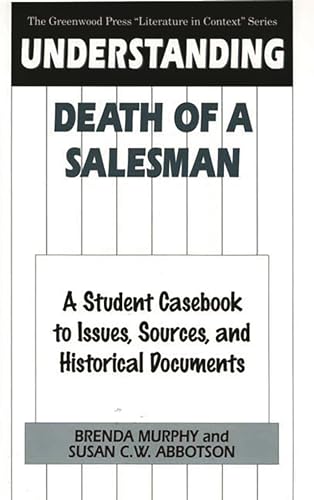Synopsis
This collection of social, cultural, and historical documents and popular materials, with linking explanations and commentary, will help the reader to study the play in the context of its time and cultural background. The collected materials are designed to work with the play to highlight inherent conflicts within American society which lie at the heart of Death of a Salesman, and to explore how the play affects and is affected by social mores and beliefs. Salesmanship and the changing face of business, along with perceptions of sports, gender, and families, are explored through selections drawn from a rich variety of sources that help provide forceful evidence of the play's influence. Documents include essays, articles, and fiction, which have created or explored the social expectations of a typical American family in the late 1940s; unusual selections such as a self-analysis chart, an obituary, and a diary, which help to trace the history of salesmanship from the nineteenth century to the present day; and advertisements, song lyrics, speeches, how-to books, and other readings that promote an interdisciplinary study of the play.
More than 70 short primary documents illustrate the cultural, social and historical milieu of the time in which the play takes place. Topics explored under Cultural Myths and Values include the Protestant work ethic vs. myths of success, the myth of the golden West vs. urban myth, and the culture of youth vs. the culture of age. A chapter on economic forces provides materials on business vs. morality, humanity vs. technology, the haves and the have-nots, American business culture, the Depression, and how to be an effective salesman. A chapter on family and gender expectations includes documents on the roles of fathers and mothers, providers vs. cowboys or playboys, and homemakers vs. call girls. A chapter on sports and leisure features documents on amateur football and sports and American values. A final chapter examines the impact of Death of a Salesman on American culture. Each chapter is followed by study questions, topics for writing and discussion, and a list of suggested reading. This work is an ideal companion for interdisciplinary study of the play.
About the Authors
Brenda Murphy is Board of Trustees Distinguished Professor of English at the University of Connecticut, where she has taught since 1989, following fourteen years as a faculty member and administrator at St Lawrence University. She is the author of many articles, books, and reviews on drama and American literature.
Susan Abbotson is Professor of English at Rhode Island College, where she mostly teaches drama. She is the author of Student Companion to Arthur Miller (2000) and A Critical Companion to Arthur Miller (2007) and numerous articles on Arthur Miller and other modern and contemporary playwrights. Past President of the Arthur Miller Society, she now manages their website and FaceBook page, and is the Performance Editor for the Arthur Miller Journal. She also authored Thematic Guide to Modern Drama (2003), Masterpieces of Twentieth Century American Drama (2005), and Modern American Drama: Playwriting in the 1950s (2019). She has published articles on Sam Shepard, Tom Stoppard, Mae West, Tennessee Williams, Thornton Wilder, August Wilson, Eugene O’Neill, Lillian Hellman, and Paula Vogel in a variety of books and journals. Susan C.W. Abbotson has taught English for more than 15 years, first at the high school level and now at Rhode Island College. Her previous books include Thematic Guide to Modern Drama (2003), Student Companion to Arthur Miller (2000), and Understanding Death of a Salesman (1999), all available from Greenwood Press.
"About this title" may belong to another edition of this title.
